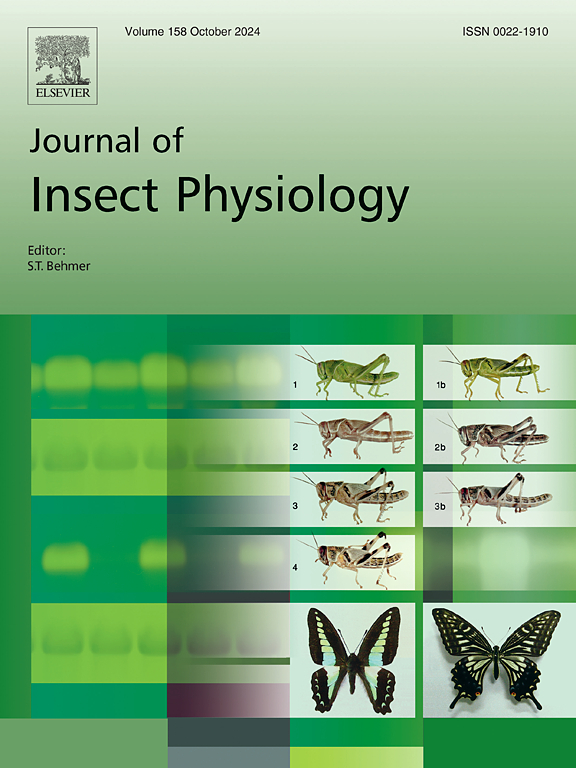斑点隐尾虫和白蚁发育过程中表皮氮经济性的研究。
IF 2.3
2区 农林科学
Q1 ENTOMOLOGY
引用次数: 0
摘要
氮在昆虫发育和繁殖过程中的作用是物种成功的关键,对食木类群至关重要。通过对食木白蚁与隐尾虫属亚社会性食木蟑螂的比较,作者提出白蚁的社会性进化涉及氮分配策略的根本转变。隐尾蚴在长达数年的发育过程中,个体的大小和表皮密度逐渐增加,表现出氮储存经济性。然而,白蚁仍然处于幼体形态,角质层的投入很少,这表明氮是根据蚁群的需要通过营养和同类相食等行为保存和循环的。本文研究了点隐尾蚴(Cryptocercus punctulatus)和湿木白蚁(netermes jouteli)的氮经济,重点分析了发育过程中表皮氮的投入和蜕皮过程中脱落氮的损失。隐尾蚴从孵化时的苍白、薄、软的角质层逐渐转变为成虫时的深色、厚、严重硬化的角质层;N/mg角质层和角质层儿茶酚胺含量的增加与这些个体发生的颜色变化有关。不同龄期幼鱼的氮含量及蜕皮后的废皮中氮含量存在显著差异。士兵和贵族种姓的黑化/硬化指数最高;假门菌含量与I类(3龄和4龄)马尾松幼鱼相当。黄颡鱼和三岁左右的小针叶鱼的外皮含量分别为72.9 μgN/mg和82.6 μgN/mg。我们的数据支持了一种假设,即白蚁从亚社会性蟑螂祖先进化而来的群居性根植于它们的低氮饮食所施加的慢性适应性限制。本文章由计算机程序翻译,如有差异,请以英文原文为准。

Cuticular nitrogen economy during development in the cockroach Cryptocercus punctulatus and the termite Neotermes jouteli
The role of nitrogen during insect development and reproduction is key in the success of a species, and is of primary importance in wood feeding taxa. Based on comparison of xylophagous, one-piece termites to the termite sister group, subsocial wood-feeding cockroaches in the genus Cryptocercus, it has been proposed that the evolution of termite eusociality involved a fundamental shift in nitrogen allocation strategies. Cryptocercus exhibits a nitrogen storage economy, with individuals gradually increasing in size and cuticular density over a years-long developmental period. Termites, however, remain in a juvenilized morphotype with minimal investment into cuticle, suggesting that nitrogen is conserved and circulated according to the needs of the colony via behaviors such as trophallaxis and cannibalism. We examined the nitrogen economy of Cryptocercus punctulatus and the dampwood termite Neotermes jouteli, focusing on cuticular nitrogen investment during development and exuvial nitrogen losses resulting from molting. Cryptocercus progressively changes from a pale, thin, soft cuticle at hatch to a dark, thick, heavily sclerotized cuticle in adults; increases in N/mg cuticle and the quantity of cuticular catecholamines are correlated with these ontogenetic color changes. There were significant differences in the nitrogen content of two successive age classes of early stage juveniles and in their discarded exuvia at molt. Soldier and alate castes of N. jouteli exhibited the highest sclerotization/melanization indices; pseudergates had levels comparable to those measured in Class I (3rd and 4th instar) juveniles of C. punctulatus. Exuvia of N. jouteli contained 0.19 μgN/mg, while exuvia of approximately two- and three-year-old C. punctulatus had 72.9 and 82.6 μgN/mg, respectively. Our data support the hypothesis that the evolution of termite eusociality from subsocial cockroach ancestors was rooted in chronic fitness limitations imposed by their low nitrogen diet.
求助全文
通过发布文献求助,成功后即可免费获取论文全文。
去求助
来源期刊

Journal of insect physiology
生物-昆虫学
CiteScore
4.50
自引率
4.50%
发文量
77
审稿时长
57 days
期刊介绍:
All aspects of insect physiology are published in this journal which will also accept papers on the physiology of other arthropods, if the referees consider the work to be of general interest. The coverage includes endocrinology (in relation to moulting, reproduction and metabolism), pheromones, neurobiology (cellular, integrative and developmental), physiological pharmacology, nutrition (food selection, digestion and absorption), homeostasis, excretion, reproduction and behaviour. Papers covering functional genomics and molecular approaches to physiological problems will also be included. Communications on structure and applied entomology can be published if the subject matter has an explicit bearing on the physiology of arthropods. Review articles and novel method papers are also welcomed.
 求助内容:
求助内容: 应助结果提醒方式:
应助结果提醒方式:


